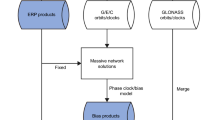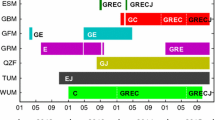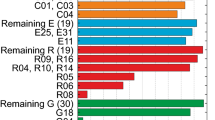Abstract
The development of the COMPASS satellite system is introduced, and the regional tracking network and data availability are described. The precise orbit determination strategy of COMPASS satellites is presented. Data of June 2012 are processed. The obtained orbits are evaluated by analysis of post-fit residuals, orbit overlap comparison and SLR (satellite laser ranging) validation. The RMS (root mean square) values of post-fit residuals for one month’s data are smaller than 2.0 cm for ionosphere-free phase measurements and 2.6 m for ionosphere-free code observations. The 48-h orbit overlap comparison shows that the RMS values of differences in the radial component are much smaller than 10 cm and those of the cross-track component are smaller than 20 cm. The SLR validation shows that the overall RMS of observed minus computed residuals is 68.5 cm for G01 and 10.8 cm for I03. The static and kinematic PPP solutions are produced to further evaluate the accuracy of COMPASS orbit and clock products. The static daily COMPASS PPP solutions achieve an accuracy of better than 1 cm in horizontal and 3 cm in vertical. The accuracy of the COMPASS kinematic PPP solutions is within 1–2 cm in the horizontal and 4–7 cm in the vertical. In addition, we find that the COMPASS kinematic solutions are generally better than the GPS ones for the selected location. Furthermore, the COMPASS/GPS combinations significantly improve the accuracy of GPS only PPP solutions. The RMS values are basically smaller than 1 cm in the horizontal components and 3–4 cm in the vertical component.









Similar content being viewed by others
References
Blewitt G (1990) An automatic editing algorithm for GPS data. Geophys Res Lett 17(3):199–202. doi:10.1029/GL017i003p00199
Gao GX, Chen A, Lo S, De Lorenzo D, Walter T, Enge P (2009) Compass-M1 broadcast codes in E2, E5b, and E6 frequency bands. IEEE J Sel Top Signal Process 3(4):599–612. doi:10.1109/JSTSP.2009.2025635
Ge M, Zhang HP, Jia XL, Song SL, Wickert L (2012) What is achievable with the current COMPASS Constellations? In: Proceedings of the 25th International Technical Meeting of the Satellite Division of The Institute of Navigation (ION GNSS 2012), Nashville, 17–21 Sept 2012
Geng J, Meng X, Dodson A, Teferle F (2010) Integer ambiguity resolution in precise point positioning: method comparison. J Geod 84(9):569–581. doi:10.1007/s00190-010-0399-x
Grelier T, Dantepal J, Delatour A, Ghion A, Ries L (2007a) Initial observations and analysis of compass MEO satellite signals. Inside GNSS 2(4):39–43
Grelier T, Ghion A, Dantepal J, Delatour A, Issler J-L, Avila-Rodriguez JA, Wallner S, Hein GW (2007b) Compass signal structure and first measurements. In: Proceedings of the 20th International Technical Meeting of the Satellite Division of The Institute of Navigation (ION GNSS 2007), Fort Worth, 25–28 Sept 2012
Hauschild A, Montenbruck O, Sleewaegen J-M, Huisman L, Teunissen PG (2012) Characterization of compass M-1 signals. GPS Solut 16:117–126. doi:10.1007/s10291-011-0210-3
Kouba J (2009) A simplified yaw-attitude model for eclipsing GPS satellites. GPS Solut 13:1–12. doi:10.1007/s10291-008-0092-1
Liu JN, Ge MR (2003) PANDA software and its preliminary result of positioning and orbit determination. Wuhan Univ J Nat Sci 8(2B):603–609. doi:10.1007/BF02899825
McCarthy DD, Petit G (2003) IERS Conventions (2003). IERS Technical Note No. 32, Bundesamt fuer Kartographie und Geodaesie, Frankfurt
Montenbruck O, Hauschild A, Steigenberger P, Hugentobler U, Teunissen P, Nakamura S (2012) Initial assessment of the COMPASS/BeiDou-2 regional navigation satellite system. GPS Solut. doi:10.1007/s10291-012-0272-x
Pearlman MR, Degnan JJ, Bosworth JM (2002) The International Laser Ranging Service. Adv Space Res 30:135–143. doi:10.1016/S0273-1177(02)00277-6
Popugaev AE, Wansch R (2011) Multi-band GNSS antenna. In: Heuberger A, Elst G, Hanke R (eds) Microelectronic Systems. Springer, Berlin/Heidelberg, pp 69–75. doi:10.1007/978-3-642-23071-4_8
Shi C, Lou Y, Zhang H, Zhao Q, Geng J, Wang R, Fang R, Liu J (2010) Seismic deformation of the Mw 8.0 Wenchuan earthquake from high-rate GPS observations. Adv Space Res 46:228–235. doi:10.1016/j.asr.2010.03.006
Shi C, Zhao Q, Geng J, Lou Y, Ge M, Liu J (2008) Recent development of PANDA software in GNSS data processing. In: Proceeding of the Society of Photographic Instrumentation Engineers, 7285, 72851S. doi: 10.1117/12.816261
Shi C, Zhao Q, Hu Z, Liu J (2013) Precise relative positioning using real tracking data from COMPASS GEO and IGSO satellites. GPS Solut 17:103–119. doi:10.1007/s10291-012-0264-x
Springer TA, Beutler G, Rothacher M (1999) A new solar radiation pressure model for GPS satellites. GPS Solut 2:50–62. doi:10.1007/PL00012757
Steigenberger P, Hugentobler U, Montenbruck O, Hauschild A (2011) Precise orbit determination of GIOVE-B based on the CONGO network. J Geod 85:357–365. doi:10.1007/s00190-011-0443-5
Wu JT, Wu SC, Hajj GA, Bertiger WI, Lichten SM (1993) Effects of antenna orientation on GPS carrier phase. Manuscr Geod 18:91–98
Zhao Q (2004) Research on precise orbit determination theory and software of both GPS navigation constellation and LEO satellites. School of Geodesy and Geomatics, Wuhan University, Wuhan (PhD dissertation in Chinese with an abstract in English)
Zhao Q, Guo J, Hu Z, Shi C, Liu J, Cai H, Liu X (2011) GRACE gravity field modeling with an investigation on correlation between nuisance parameters and gravity field coefficients. Adv Space Res 47:1833–1850. doi:10.1016/j.asr.2010.11.041
Zhang S, Guo J, Li B, Rizos C (2011) An analysis of satellite visibility and relative positioning precision of COMPASS. In: Symposium for Chinese Professionals in GPS, Shanghai, 18–20 Aug 2011
Acknowledgments
This work is partially supported by the National Nature Science Foundation of China (Projects 41231174, 41274049), the National “863 Program” of China (Grant No. 2012AA12A202), the “111 Project” of China (Grant No. B07037), and the Open Fund of Key Laboratory of Precision Navigation and Technology, National Time Service Center (Grant No. 2012PNTT06). We would also like to thank Mr. Xiaotao Li for managing data of the CETN stations. The authors are thankful to Dr. X. Liu, who considerably revised the manuscript. Finally, the authors are also grateful for the comments and remarks of three reviewers, which helped to significantly improve the manuscript.
Author information
Authors and Affiliations
Corresponding authors
Rights and permissions
About this article
Cite this article
Zhao, Q., Guo, J., Li, M. et al. Initial results of precise orbit and clock determination for COMPASS navigation satellite system. J Geod 87, 475–486 (2013). https://doi.org/10.1007/s00190-013-0622-7
Received:
Accepted:
Published:
Issue Date:
DOI: https://doi.org/10.1007/s00190-013-0622-7




